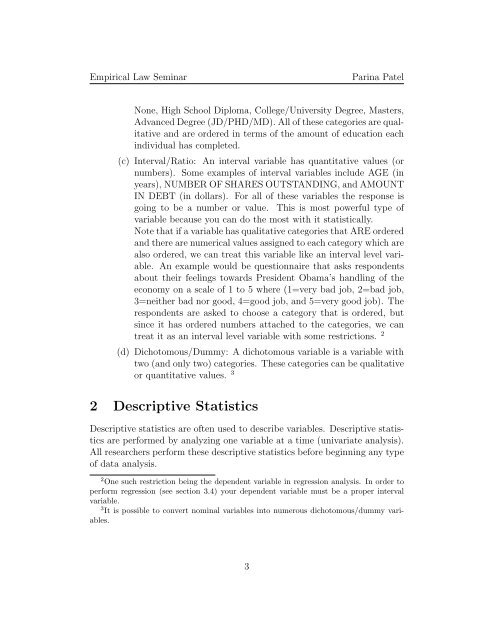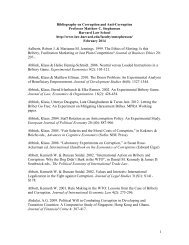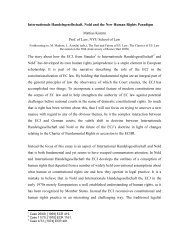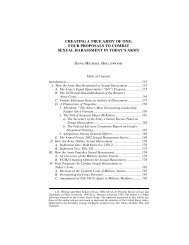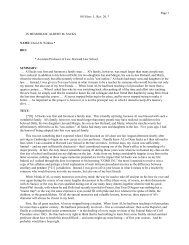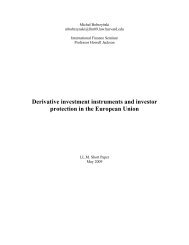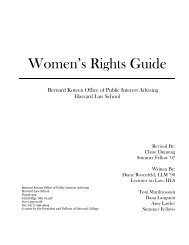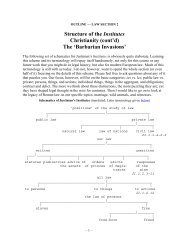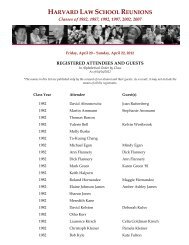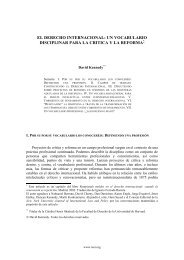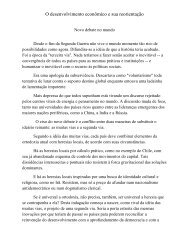Introduction to Quantitative Methods - Harvard Law School
Introduction to Quantitative Methods - Harvard Law School
Introduction to Quantitative Methods - Harvard Law School
Create successful ePaper yourself
Turn your PDF publications into a flip-book with our unique Google optimized e-Paper software.
Empirical <strong>Law</strong> Seminar Parina Patel<br />
None, High <strong>School</strong> Diploma, College/University Degree, Masters,<br />
Advanced Degree (JD/PHD/MD). All of these categories are qualitative<br />
and are ordered in terms of the amount of education each<br />
individual has completed.<br />
(c) Interval/Ratio: An interval variable has quantitative values (or<br />
numbers). Some examples of interval variables include AGE (in<br />
years), NUMBER OF SHARES OUTSTANDING, and AMOUNT<br />
IN DEBT (in dollars). For all of these variables the response is<br />
going <strong>to</strong> be a number or value. This is most powerful type of<br />
variable because you can do the most with it statistically.<br />
Note that if a variable has qualitative categories that ARE ordered<br />
and there are numerical values assigned <strong>to</strong> each category which are<br />
also ordered, we can treat this variable like an interval level variable.<br />
An example would be questionnaire that asks respondents<br />
about their feelings <strong>to</strong>wards President Obama’s handling of the<br />
economy on a scale of 1 <strong>to</strong> 5 where (1=very bad job, 2=bad job,<br />
3=neither bad nor good, 4=good job, and 5=very good job). The<br />
respondents are asked <strong>to</strong> choose a category that is ordered, but<br />
since it has ordered numbers attached <strong>to</strong> the categories, we can<br />
treat it as an interval level variable with some restrictions. 2<br />
(d) Dicho<strong>to</strong>mous/Dummy: A dicho<strong>to</strong>mous variable is a variable with<br />
two (and only two) categories. These categories can be qualitative<br />
or quantitative values. 3<br />
2 Descriptive Statistics<br />
Descriptive statistics are often used <strong>to</strong> describe variables. Descriptive statistics<br />
are performed by analyzing one variable at a time (univariate analysis).<br />
All researchers perform these descriptive statistics before beginning any type<br />
of data analysis.<br />
2 One such restriction being the dependent variable in regression analysis. In order <strong>to</strong><br />
perform regression (see section 3.4) your dependent variable must be a proper interval<br />
variable.<br />
3 It is possible <strong>to</strong> convert nominal variables in<strong>to</strong> numerous dicho<strong>to</strong>mous/dummy vari-<br />
ables.<br />
3


